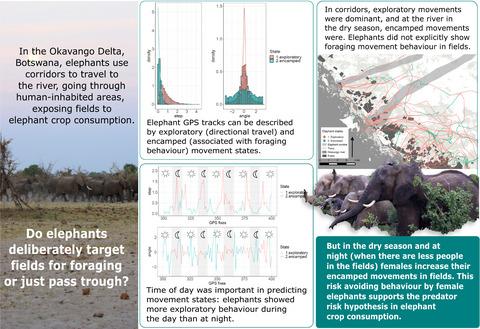当前位置:
X-MOL 学术
›
J. Anim. Ecol.
›
论文详情
Our official English website, www.x-mol.net, welcomes your feedback! (Note: you will need to create a separate account there.)
Exploring movement decisions: can Bayesian movement‐state models explain crop consumption behaviour in elephants ( Loxodonta africana )?
Journal of Animal Ecology ( IF 4.8 ) Pub Date : 2020-04-01 , DOI: 10.1111/1365-2656.13177 Susanne Marieke Vogel 1, 2, 3, 4 , Ben Lambert 1, 5 , Anna Catherine Songhurst 1, 2, 6 , Graham Paul McCulloch 1, 2, 6 , Amanda Lee Stronza 2, 6 , Tim Coulson 1
Journal of Animal Ecology ( IF 4.8 ) Pub Date : 2020-04-01 , DOI: 10.1111/1365-2656.13177 Susanne Marieke Vogel 1, 2, 3, 4 , Ben Lambert 1, 5 , Anna Catherine Songhurst 1, 2, 6 , Graham Paul McCulloch 1, 2, 6 , Amanda Lee Stronza 2, 6 , Tim Coulson 1
Affiliation

|
Animal movements towards goals or targets are based upon either maximization of resource acquisition or risk avoidance, and the way animals move can reveal information about their motivation. We use hidden Markov models fitted in a Bayesian framework and hourly GPS-fixes to distinguish animal movements into distinct states and analyse the influence of environmental variables on being in, and switching to, a particular state. Specifically, we apply our models to understand elephant movement decisions around agricultural fields, and crop consumption. As it is unclear what the role of habitat features are on this complex process, we analyse whether elephants target agricultural crops for consumption, or simply pass through them in search of water. Our hidden Markov models separate elephant movements into two states: exploratory movements that are fast and directional, and encamped movements that are slow and meandering. For each elephant, we ran 16 models with each possible combination of selected habitat features (river, elephant corridor, agricultural field, trees), and repeated these analyses including interaction effects with both season and time of day. We used cross-validation to select the best model. In corridors, exploratory movements are dominant. Elephants mainly showed encamped movements at the river during the dry season, when temporary water sources have dried out and elephants relied on this permanent water source. In fields, males most often exhibited exploratory movements to and from the river, while females showed an increase in the frequency of encamped behaviour during the dry season and at night - the times when most crop consumption and movements through fields occur. Adaptation to risk could explain this behaviour, since foraging in fields is likely less risky under the cover of darkness and during the dry season when farmers are absent. This sex segregation in elephant movement decisions highlights the importance of predation risk in shaping movement patterns, which can result in sex segregation in responses to mitigation methods. The increase in encamped movements in the dry season suggests the importance of agricultural timing, and shows the potential for early ploughing and early-harvest crop types in order to reduce elephant crop consumption. Taking this into account could increase efficiency of elephant crop consumption mitigation.
中文翻译:

探索运动决策:贝叶斯运动状态模型能否解释大象(非洲象属)的作物消费行为?
动物朝着目标或目标的运动基于资源获取的最大化或风险规避,而动物的运动方式可以揭示有关其动机的信息。我们使用贝叶斯框架中的隐马尔可夫模型和每小时 GPS 定位来区分动物运动到不同的状态,并分析环境变量对处于和切换到特定状态的影响。具体来说,我们应用我们的模型来了解大象在农田和作物消费方面的移动决策。由于尚不清楚栖息地特征在这一复杂过程中的作用,我们分析了大象是将农作物作为消费目标,还是只是穿过它们寻找水源。我们的隐马尔可夫模型将大象的运动分为两种状态:快速和定向的探索性运动,以及缓慢而曲折的扎营运动。对于每头大象,我们使用所选栖息地特征(河流、大象走廊、农田、树木)的每种可能组合运行 16 个模型,并重复这些分析,包括与季节和时间的交互效应。我们使用交叉验证来选择最佳模型。在走廊中,探索性运动占主导地位。大象在旱季主要表现在河边扎营活动,此时临时水源已经干涸,大象依赖这个永久水源。在田间,雄性最常表现出进出河流的探索性运动,而女性在旱季和夜间露营行为的频率有所增加 - 这是大多数作物消耗和通过田地运动发生的时间。对风险的适应可以解释这种行为,因为在黑暗的掩护下和农民不在的旱季,在田间觅食的风险可能较小。大象运动决策中的这种性别隔离突出了捕食风险在塑造运动模式方面的重要性,这可能导致在应对缓解方法时出现性别隔离。旱季扎营活动的增加表明了农业时间的重要性,并显示了早耕早收作物类型以减少大象作物消费的潜力。
更新日期:2020-04-01
中文翻译:

探索运动决策:贝叶斯运动状态模型能否解释大象(非洲象属)的作物消费行为?
动物朝着目标或目标的运动基于资源获取的最大化或风险规避,而动物的运动方式可以揭示有关其动机的信息。我们使用贝叶斯框架中的隐马尔可夫模型和每小时 GPS 定位来区分动物运动到不同的状态,并分析环境变量对处于和切换到特定状态的影响。具体来说,我们应用我们的模型来了解大象在农田和作物消费方面的移动决策。由于尚不清楚栖息地特征在这一复杂过程中的作用,我们分析了大象是将农作物作为消费目标,还是只是穿过它们寻找水源。我们的隐马尔可夫模型将大象的运动分为两种状态:快速和定向的探索性运动,以及缓慢而曲折的扎营运动。对于每头大象,我们使用所选栖息地特征(河流、大象走廊、农田、树木)的每种可能组合运行 16 个模型,并重复这些分析,包括与季节和时间的交互效应。我们使用交叉验证来选择最佳模型。在走廊中,探索性运动占主导地位。大象在旱季主要表现在河边扎营活动,此时临时水源已经干涸,大象依赖这个永久水源。在田间,雄性最常表现出进出河流的探索性运动,而女性在旱季和夜间露营行为的频率有所增加 - 这是大多数作物消耗和通过田地运动发生的时间。对风险的适应可以解释这种行为,因为在黑暗的掩护下和农民不在的旱季,在田间觅食的风险可能较小。大象运动决策中的这种性别隔离突出了捕食风险在塑造运动模式方面的重要性,这可能导致在应对缓解方法时出现性别隔离。旱季扎营活动的增加表明了农业时间的重要性,并显示了早耕早收作物类型以减少大象作物消费的潜力。


























 京公网安备 11010802027423号
京公网安备 11010802027423号